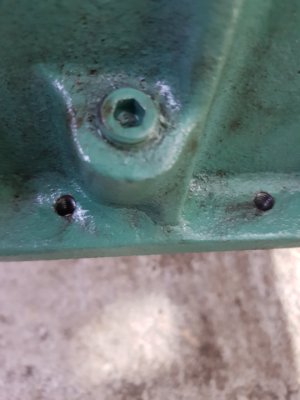Good Day,
I hope you don't mind me posting here, but I am looking for advise on a mishap I have had whilst cleaning out some threads.
I am not an engineer by trade, I'm just starting out as a hobby, and am rebuilding a marine diesel. The threads in the block for the sump bolts were contaminated and the bolts themselves in poor condition, so I decided to replace the bolts, new sprung washers, and run a tap through the threads to clean out the corrosion and detritus. The block is cast iron, the thread 5/16" UNC, and the bolts class 2A, grade 2, self colour. Length of engagement 0.6". The weight of the sump and oil is about 140lbs and the manual specifies max 17 ft-lbs of torque on each of the 34 bolts.
I purchased a set of UNC/UNF taps, ran the first one, checked the bolt and then ran the tap through the rest. I'm kicking myself now for not checking thoroughly enough, being in a rush, for when I came to bolt the sump back on I noticed excess play in the bolts. Checking the tap, I see a major diameter of 8.3mm and a minor diameter of 6.7mm. It's even marked "5/16 NF 18" which makes no sense (the fine tap is marked "5/16 NF 24" which is a bit better I suppose).
I am worried about stripping the internal thread when reassembling and also about the bolts coming loose through lack of friction and loss of thread engagement.
The way I see it I can either reassemble to specified torque using sprung washers and perhaps locktite 242 or I can use an insert such as Helicoil.
The problem with the second option is difficult access, the engine is pretty much assembled so to drill the holes it would have to be a hand drill. Then I'm not sure about the amount of material to actually drill into, I am guessing for a 5/16" Helicoil I would have to enlarge the hole by about 0.1" and as you can see from the picture they already are up against the fillet of the block.
Can anyone advise on the best approach to this mess?
Much appreciated,
Richard
I hope you don't mind me posting here, but I am looking for advise on a mishap I have had whilst cleaning out some threads.
I am not an engineer by trade, I'm just starting out as a hobby, and am rebuilding a marine diesel. The threads in the block for the sump bolts were contaminated and the bolts themselves in poor condition, so I decided to replace the bolts, new sprung washers, and run a tap through the threads to clean out the corrosion and detritus. The block is cast iron, the thread 5/16" UNC, and the bolts class 2A, grade 2, self colour. Length of engagement 0.6". The weight of the sump and oil is about 140lbs and the manual specifies max 17 ft-lbs of torque on each of the 34 bolts.
I purchased a set of UNC/UNF taps, ran the first one, checked the bolt and then ran the tap through the rest. I'm kicking myself now for not checking thoroughly enough, being in a rush, for when I came to bolt the sump back on I noticed excess play in the bolts. Checking the tap, I see a major diameter of 8.3mm and a minor diameter of 6.7mm. It's even marked "5/16 NF 18" which makes no sense (the fine tap is marked "5/16 NF 24" which is a bit better I suppose).
I am worried about stripping the internal thread when reassembling and also about the bolts coming loose through lack of friction and loss of thread engagement.
The way I see it I can either reassemble to specified torque using sprung washers and perhaps locktite 242 or I can use an insert such as Helicoil.
The problem with the second option is difficult access, the engine is pretty much assembled so to drill the holes it would have to be a hand drill. Then I'm not sure about the amount of material to actually drill into, I am guessing for a 5/16" Helicoil I would have to enlarge the hole by about 0.1" and as you can see from the picture they already are up against the fillet of the block.
Can anyone advise on the best approach to this mess?
Much appreciated,
Richard


